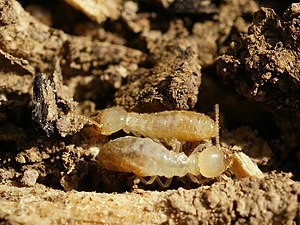Rhinotermitidae
| Rhinotermitidae | ||||||||||
|---|---|---|---|---|---|---|---|---|---|---|

|
||||||||||
| Systematics | ||||||||||
|
||||||||||
| Scientific name | ||||||||||
| Rhinotermitidae | ||||||||||
| Light , 1921 |
The Rhinotermitidae are a family of termites (Isoptera). It is spread all over the world.
features
This family of termites includes species in which soldiers have an opening on their heads called a fontanel. A special, unpaired gland within the head capsule called the frontal gland, which can extend into the abdomen , can produce toxic or very sticky secretions. These are sprayed or hurled at enemies through the fontanel. In addition, the mandibles can also be used to inflict bite wounds on enemies through which the poisonous secretions can penetrate.
In the Rhinotermitinae subfamily , the species have an elongated, brush-like labrum that they can use to smear toxic fluids into the wound after a bite.
All species of Rhinotermitidae have eight Malpighian tubes as an excretory organ and various short sections in front of the chamber of the rectum, in which wood digestion takes place with the help of symbiotic protozoa , bacteria and archaebacteria .
distribution
The Rhinotermitidae family is one of the most common termite families. Their range includes the tropical , subtropical and temperate zones. Most of the 345 species in this family live in warm areas, but there are also seven species in Europe, including southern England and Germany. In the United States, they are represented in all states except Alaska.
Way of life
The structures of this termite family are built in the ground, but many species feed on wood. The wood-eating species can cause serious damage to homes or other wooden structures. A distinction is made between 345 species , including the species Coptotermes formosanus , Coptotermes gestroi and Reticulitermes flavipes , which are classified as pests . Other species, especially from the subfamily Psammotermitinae , eat grass and are considered to be the cause of the so-called fairy circles in grasslands.
Systematics
- Subfamily Coptotermitinae Holmgren, 1910a (Synonym Arrhinotermitinae Sjöstedt, 1926 )
- Subfamily Heterotermitinae Froggatt, 1897 (synonym Leucotermitinae Holmgren, 1910a )
- Subfamily Prorhinotermitinae Quennedey & Deligne, 1975
- Subfamily Psammotermitinae Holmgren, 1911
- Subfamily Rhinotermitinae Froggatt, 1897
- Termitogetoninae Holmgren subfamily , 1910a
The subfamily Stylotermitinae with the genus Stylotermes was spun off and established as a separate family Stylotermitidae .
Individual evidence
- ↑ A. Quennedey, J. Deligne: L'arme frontale des soldats de termites - I. Rhinotermitidae. Insectes Sociaux, 22, pp. 243-267, 1975 doi: 10.1007 / BF02223076 .
- ^ A b Thomas Bourguignon & Yves Roisin: Revision of the termite family Rhinotermitidae (Isoptera) in New Guinea. ZooKeys 148, 2011, pp. 55-103. ( PMC 3264403 (free full text)).
- ↑ PN Chatterjee, ML Thakur: Sarvaritermes faveolus gen. Et sp. nov. from Kulu Valley (Punjab: India) [Isoptera], with a discussion on the systematic position and relationship of the family Stylotermitidae. Zoologischer Anzeiger, 173, pp. 149-162, 1964.
literature
- SF Light: Notes on Philippine termites, II. The Philippine Journal of Science, 19, pp. 23–63, 1921 (first description)
- JW Austin, AL Szalanski & BJ Cabrera: Molecular phylogeny of the Rhinotermitidae . In: Annals of the Entomological Society of America . tape 3 , 2004, p. 548-555 , col. 97 (English).
- Lo, N., O. Kitade, T. Miura, R. Constantino, and T. Matsumoto: Phylogenetic Analysis of the Subterranean Termite Family Rhinotermitidae (Isoptera) by Using the Mitochondrial Cytochrome Oxidase II Gene . In: Insectes Sociaux . tape 4 , 2004, p. 365-371 , col. 51 (English, esources.metapress.com [PDF]).
- EL Vargo and C. Husseneder: Biology of subterranean termites: Insights from molecular studies of Reticulitermes and Coptotermes . In: Annual Review of Entomology . tape 4 , 2009, p. 379-403 , col. 54 (English).